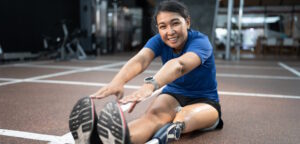An Overview of the Main Stages of Amputation Recovery
Undergoing an amputation surgery is a monumental change in a person’s life. In addition to going through the amputation recovery process, patients must also make a lifestyle change as they adapt to using advanced prosthetics. Make no mistake, it is a physically and emotionally taxing process.
However, patients find the process is easier when they know what to expect during their journey to recovery. To provide some insight, we are breaking down the stages of recovery that patients go through after an amputation surgery. Further, we will provide information about how to contact a prosthetist for a prosthetic exam and what to look for during your vetting process.
Stage 1 – Post-Amputation Surgery
Around the time of the patient’s surgery – either before or after the day of surgery – they will meet with a prosthetist to discuss what to expect over the course of the next several weeks and months.
After amputation surgery, patients may spend upwards of two weeks in the hospital under the care of their physician and nursing staff. The time varies from person to person since different types of amputation heal at different rates. Lifestyle factors also play a role, such as diet, health, and whether the patient is a tobacco user.
The main goal after amputation surgery is caring for the amputation site and ensuring it doesn’t get infected. The residual limb will be dressed in bandages and put into a brace called a knee immobilizer, which offers the leg protection and keeps it correctly positioned. It’s extremely important for those with a below-knee amputation to keep their knee straight the majority of the day to avoid potential contractures.
Light rehabilitation will begin a day or two after surgery. Patients will remove the knee immobilizer device during rehab sessions, which mainly consist of simple stretching and strength exercises (lower extremity, as well as upper extremity) to keep the muscles strong while the patient is recovering. Patients also will engage in exercises that are intended to prevent blood clots from forming.
It is also common for patients to experience shooting pains in the limb that was amputated, which is referred to as phantom limb pain. Patients are occasionally given medication for phantom limb pain and residual limb pain when required.
Stage 2 – Prepping the Residual Limb for a Prosthetics Exam
After being discharged post-amputation surgery, the main goal is to get the residual limb to a point where it is ready for a prosthetics exam and fitting. Depending on how well the residual limb is cared for, this stage of amputation recovery may take around a month or so. Staples and/or sutures are usually removed no later than the six-week mark, if fully healed.
To speed their recovery along, patients should keep up with all follow-up appointments to get their amputation site checked out and redressed as needed. They should also follow the directions provided to them by their rehabilitation doctor and physical therapist pertaining to at-home care, exercises, and use of medical devices.
Patients will begin wearing a compression garment known as a stump shrinker. This device helps reduce the swelling at the amputation site and helps arrive at a more uniform shape of the residual limb, the latter of which becomes relevant when the patient begins getting fitted for prosthetic devices. Regardless of whether the amputation is above-knee or below-knee, the stump shrinker is worn 24/7, unless bathing or switching out with their alternate stump shrinker.
As the residual limb heals, it’s important that patients continue to build strength and flexibility in other muscle groups. Additionally, patients should be mindful of their own mental health, which is why it’s occasionally recommended to speak with a rehabilitation psychologist. These mental health professionals assist those who have undergone amputation surgery process their grief and help them adjust to their new lifestyle.
Stage 3 – Getting a Prosthetics Exam
Before a patient can be fitted with a prosthesis, they are required to get a prosthetic evaluation exam performed by a rehabilitation doctor for insurance purposes; the prosthetist can arrange this exam on the patient’s behalf.
Once the residual limb is properly healed and the insurance provider has given their formal approval, patients are cleared to get a temporary prosthesis fitting. Prosthetics exams typically happen eight to twelve weeks after the initial surgery. A cast of the residual limb is taken. This is followed by one or two diagnostic socket fittings before completing the prosthesis. The temporary prosthesis is intended for wear as the residual limb continues to shrink and heal. During the initial appointment with their prosthetist, they will explain to the patient how to use and clean the prosthetic limb.
They will also provide the patient with signs/symptoms to be mindful of that may indicate the prosthetic limb is causing irritation or tissue damage, and when to call for an adjustment. There is a “breaking in” period when using a prothetis, and prosthetists will often add socks and pads for comfort. It’s important for patients to keep in mind that they will visit their prosthetist many times over the next several months for adjustments and subsequent fittings. Part of that is due to how much residual limbs change for the first six to eight months of amputation recovery.
Patients should continue with their daily care regimen for their residual limb. For most patients, that means wearing their shrinker sock, taking any applicable medications, and keeping the amputation site clean. Additionally, patients should continue with their at-home stretching and strengthening exercises.
Stage 4 – Learning to Use a Prosthesis
Learning how to use a prosthetic limb is about training the mind and the body to rely on it for movement. In cases of leg amputation, patients will need to learn how to shift and distribute their weight between their remaining leg and their prosthetic leg.
Patients will work closely with their rehabilitation team as they learn to use their prosthetic limb, reclaim their mobility, and reengage in daily activities. The process is challenging, and some patients may feel like they aren’t making quick enough progress. However, learning to use a prosthesis is more about small victories than achieving overnight success. Patients who put their trust in the process and reasonably manage their expectations tend to fare better during training.
For some, learning to walk independently without the use of parallel bars or a walking aid may take as long as a year. Since the learning process is specific to the person and their condition, it’s difficult to assign an average. Amputation recovery and learning to be mobile is a highly individualized journey. For questions about how to enroll in physical therapy or to learn more about available programs and resources for amputees, patients should speak with their prosthetist.
Stage 5 – Upgrading to Advanced Prosthetics
Eventually, patients will reach a point where their residual limb has fully stabilized and is no longer changing. This means they are finally ready to transition from a temporary prosthesis to one that can last them for several years.
Once again, patients will visit their prosthetist for a prosthetics exam; however, this time it will be for a prosthetic limb that is intended for long term use. Several factors play into the selection process that patients must consider, activity level of the patient, insurance coverage/provider, and out of pocket costs.
When consulting with their prosthetist about advanced prosthetics, patients will be asked about their activity goals and what level of functionality they require. It’s also important the advanced prosthetic limb provides a comfortable fit that does not cause irritation.
Stage 6 – Ongoing Learning and Returning to Daily Activities
Once patients have transitioned over to a prosthetic limb intended for long term use, they will continue working with their rehabilitation specialist and/or physical therapist on balance, coordination, and strength.
As patients become more proficient in using advanced prosthetics, they will be able to return to their normal daily activities and take on bigger challenges. Patients will also find they have physically and mentally adapted to using a prosthetic limb. Rather than having to consciously think about balance and shifting weight, patients will find the process comes more naturally as time goes on.
How to Learn More About Amputation Recovery and Advanced Prosthetics
Those who are scheduled to undergo amputation surgery or who have recently had it performed tend to have questions about the next steps. Specifically, many patients want to get their prosthetics exam scheduled so they may consult with a prosthetist. In most cases, the patient’s physician can offer them a referral, or they can find a prosthetist online.
When searching for a prosthetist, it’s important to be mindful of industry experience, certification, and that they offer advanced prosthetics that support a range of activity levels. It’s also important to contact your prosthetist ahead of time to confirm they accept your insurance coverage.







